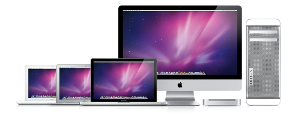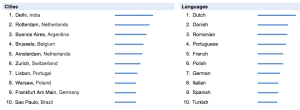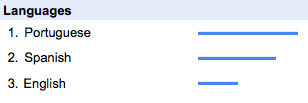
Tag: Mac
A (not so) simple question: How many Mac users are there in the world?
 How many Mac users are there in the world?
How many Mac users are there in the world?
Pretty straigthforward, huh?
Not so much.
According to Apple in May 2006, there were about 15 million Mac OS X active users worldwide.
In March 2007, the number of Mac OS X users was estimated to be 22 million strong, according to analysts at Bank of America Securities. The Leopard release generated about 6 million more users.
Continue reading “A (not so) simple question: How many Mac users are there in the world?”
Language and Regional Analysis Google’s Picasa using Google Trends
First of all, it is important to point that it is not possible to see the Daily Unique Visitors graph of http://picasa.google.com using Google Trends. Also a big mahalo (thank you in Hawaiian!) to fellow Photo Lover, Katharine Osborne, for showing me Skitch. This great little image capturing & editing tool for Mac has made my blogging much easier.
Why Picasa? Well, in my personal opinion, the 2 main players for desktop applications in photo organizing & sharing for Mac OS are:
Teaser: what are the differences between the 2 of them? : ) Coming soon!
Since it was not possible to look for the Daily Unique Visitors graph, I looked for the Search Volume Index of the term “picasa”. Here’s what you get:
The letters correspond to relevant news, here’s the list:
The biggest spike, highlighted with the letter A, happened after the release of Picasa 2.0 by Google, back in 2005 which included a series of improvements such as picture captioning and blog-posting ability (for the whole list check here). A spike in the search volume of the term “picasa” is expected around the date of a new release. This is supported by event F, because on September 3, 2008, Picasa 3.0 was released.
What was really interesting is that the United States does not appear among the top 10 regions where the term “picasa” is searched for!!
Is this possible? Is it an error? Let’s analyze the following:
Notice that there appears no U.S. city on the top 10 cities that search for “picasa” and that English does not appear on the top 10 languages!
This finding is very interesting so I adjusted the upper right setting for region from:
to:
and I found that English is the 3rd language of the region when searching for “picasa”!
Conclusions:
- The term “picasa” is searched more around the release date of a new version of Picasa.
- Google’s Picasa has a stronger presence abroad than in the United States.
- Google MUST consider that the majority of its users come from outside of the U.S., so web sites version in different languages might be needed to support its users. This situation is not strange, the same thing happened to Flickr.com.
Why are these conclusions relevant?
Consider the following for Apple’s iPhoto, when looking for the term “iphoto”, this is what I found:
Notice that:
- United States is the second region where most searches happen.
- 8 of the top 10 cities, where the searches happened, are inside of the U.S.
- English is the top language of the queries.
This illustrates the difference in strategies between Apple’s iPhoto and Google’s Picasa.
What do you think?
Apple vs Mac using Microsoft adCenter Labs
Today I began reading Avinash Kaushik’s Web Analytics: An Hour a Day. Supposedly I was going to read it for an hour (as the title clearly states!) but I found myself immersed in it for about 2 hours. The book is packed with useful terms, acronyms, companies, examples, best practices. All of this in just the first 49 pages. Just to name a few: customer driven innovation (CDI), Coremetrics, Omniture, WebTrends, WebSideStory, Clicktracks, comScore, packet sniffers, etc. A lot of food for thought for future posts here at idaconcpts.com.
Originally I wanted to discuss about Kaushik’s trinity, whose objective is actionable insights and metrics, but I got caught with Microsoft adCenter Labs.
I had no idea about the existence of this lab, so it is quite sensible to explain what it is all about (in their own words):
Microsoft adCenter Labs is an applied research group dedicated to researching and incubating new digital advertising technologies. Formed in 2006, Microsoft adCenter Labs combines the talents of more than 120 top researchers and engineers, all dedicated to developing cutting-edge ways for consumers and advertisers to connect. Our researchers work across a broad range of technology areas, including keyword and content technologies, audience intelligence, ad selection and relevance, social networking, and video and interactive media. The algorithms developed by our team operate in the engines of Microsoft adCenter products such as Paid Search, Content Ads, and Behavioral Targeting. We are also committed to investing in developing online advertising products that will shape the future of advertising through more relevant and meaningful ads across online video, television and mobile devices.
Here you can find plenty of free little tools that (if correct) would provide great insight into the field of web analytics. Just as Kaushik recommends, this website is “perfectly suited for 1) learning lots and lots and lots about search engine keyword behavior and long-term trends 2) understanding the demographic profiles for your (or your competitor’s) website visitors.”
Learning lots indeed! Today I had to continue to network to learn more about the needs of organizing large collections of photographs. I cannot go into much details but I can tell you that gender distribution is a major factor in my analysis. One particular question that I have is what are the differences between male and female Mac (or Apple!) users, and how does their experience relate to their use of Flickr. Let’s use the Keyword Forecast tool from Microsoft adCenter Labs to find some insights into this question.
According to Microsoft, “This tool forecasts the impression count and predicts demographic distributions of keywords. Enter keywords separated by semi-colons and click the submit button.”
So, I used the terms: Apple: Flickr; Mac. Originally I was going to just use Apple or Mac but after finding the results I found that there important differences about the keywords Apple and Mac.
From the graph above, it becomes clear that before March 2007, the keyword Apple had a much higher trend than the keyword Mac, something happened in March 2007 that turned the tables around for the relationship between these two keywords. I would have to look into that and a useful tool for that would be Google Trends.
But let’s continue to use this tool for now.
Wow! According to this graph, it appears that for the period 04/2006 – 06/2007, the keyword Apple is associated mostly with females and the keyword Mac is associated mostly with males. This is a key finding for marketers trying to reach a particular gender of Mac (or Apple!) users. It appears that talking about Mac to a female audience of Powerbook users is not such a good idea! Earlier we discussed that Flickr.com is very related to Divinecaroline.com, so this would be an important to consider if Flickr is trying to reach female Apple users at the latter website. The keyword Flickr has almost neutral association with either women or men so the tipping point would be the use of Apple or Mac.
Lastly, the Keyword Search tool offers an age distribution bar graph.
From the graph above, my main observations would be that 50+ old keyword users prefer the keyword Apple over Mac, and that 25-34 old keyword user prefer Mac over Apple. All other age distributions seem quite normal.
Conclusion: vive le diference! Gender is highly important for SEO for Mac related web analytics projects!
What do you think?










